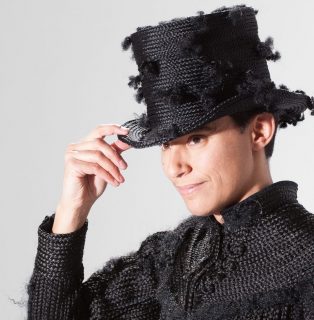Karin Jones (MFA 2018) is a multidisciplinary artist with a background in jewellery. Karin’s recent work examines the ways in which historical narratives shape our identities. She is currently an instructor at Vancouver Community College’s Jewellery Art and Design program, where she is also serving as Department Head. Her work has been exhibited in Canada, the United States, Finland, Korea and Japan.
Why did you choose NSCAD?
When I started, it was the only MFA in jewellery in Canada. Also, my father is from Nova Scotia, and I wanted to get to know the place he was from, and my relatives there, a little better. So I didn’t really consider any other institutions.
What is your fondest memory from your time at NSCAD?
The many wonderful conversations I had with faculty, classmates, and visiting artists, in my studio and over drinks on the town.
How did NSCAD help prepare you for your career?
Actually I was already well into my career when I came to NSCAD. But it really helped me to understand contemporary art better, and how to place my work within that context. Also, the MFA program was amazing for having time, space and mentorship to create the body of work which I’m now exhibiting.

Describe the importance of African Heritage Month for Black artists?
That’s a tricky question because I’m not really sure how important I think it is. It’s great that institutions will have some programming for Black artists in February, but the flip side is that there’s a risk of always having a show in February, and having nothing the rest of the year. I like to think we’ve made enough advances that galleries could just show lots of art by people of all cultures all the time, but maybe this is too optimistic! I have met a really inspiring number of Black women curators in really well-respected institutions in the past couple of years, so I really can see a near future where we don’t have to dedicate the shortest month of the year to showing Black art.
In the past 20 years, you graduated from VCC’s Jewellery Art & Design program, had exhibitions in Japan, the United States and across Canada, earned a master’s degree from NSCAD, and recently became the department head of Jewellery Design at VCC. Throughout this journey, what are the most important lessons you learned that helped shape you as an artist?
At one point I had to make a conscious effort to divorce my creative work from my financial well-being. I have experienced a certain amount of failure when it came to supporting myself with my creative work, and it was really damaging to my creativity. I also feel that I can have more freedom with my work if I don’t have to worry about it selling, or even being accepted for shows. The drawback is that my teaching job sometimes takes over and I don’t have a lot of time for my creative work. But I really don’t know a lot of people who have the perfect balance of financial stability and creativity anyway, so I think it is up to us to decide in which areas we want to make sacrifices, and when.
How does your identity inform your work?
My work is all about identity. I think when you grow up as a visible minority you can’t help but be affected by it and start questioning it at an early age, like in kindergarten. So I feel I’m constantly trying to figure out how identity works. How does the world see me? How do people and societies choose their identities? Right now I’m thinking and reading a lot about how Greek and Roman culture has basically been co-opted by all of the cultures of Europe and beyond. Why is this more a part of European identity than the Dark Ages, or the weird religious cults that emerged after the plague years? Obviously because everyone wants to claim something noble, or that they’ve been taught is noble, in their past to identify with. But I find it fascinating that we all just take this identity for granted, every time we walk past a building with Greek columns in front of it, whether it’s a courthouse, an art gallery, a university or a slave-owner’s mansion.
Discussions like these are important, where would you like to see improvements in arts education and the arts community in general?
I think institutions need to include more people of colour at every step and every level – in reading lists, in the work that’s shown in classes, in the faculty itself.
Who are the artists that you most admire? What type of influence do they have on your work?
Last year I got the chance to attend an artist talk by Kerry James Marshall in Vancouver. It was a packed house, and it was almost a religious experience for me. Sometimes I think back on that night with a sigh – the night I got to spend an hour listening to Kerry James Marshall talk about his work. I love work that has an emotional impact and is also done in a really well-thought-out way. I think there is so much art out there that relies too heavily on intellect, and it leaves me cold. So that combination of the head and the heart in art is something I really aspire to.
Learn more about Karin Jones and her work at Karinjones.ca.

